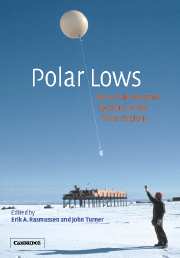1 - Introduction
Published online by Cambridge University Press: 07 December 2009
Summary
Polar lows and other mesoscale lows in the polar regions
In this volume we are concerned with the whole range of mesoscale lows with a horizontal length scale of less than c. 1000 km that occur in the Arctic and Antarctic poleward of the main polar front or other major frontal zones. However, much of the interest will be focused on the more intense systems, the so-called polar lows. The term mesocyclone covers a very wide range of weather systems from insignificant, minor vortices with only a weak cloud signature and no surface circulation, to the very active maritime disturbances known as polar lows, which in extreme cases may have winds of hurricane force and bring heavy snowfall to some areas. Clearly it is very important to be able to forecast these more active systems since they can pose a serious threat to marine operations and coastal communities when they make landfall.
Although it has been known for many years in high latitude coastal communities that violent small storms could arrive with little warning, it was only with the general availability of imagery from the polar orbiting weather satellites in the 1960s that it was realized that these phenomena were quite common. The imagery indicated that the storms developed over the high latitude ocean areas (generally during the winter months) and tended to decline rapidly once they made landfall.
- Type
- Chapter
- Information
- Polar LowsMesoscale Weather Systems in the Polar Regions, pp. 1 - 51Publisher: Cambridge University PressPrint publication year: 2003
- 5
- Cited by



